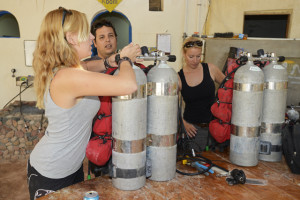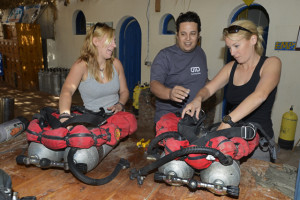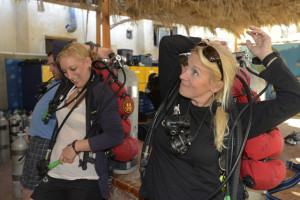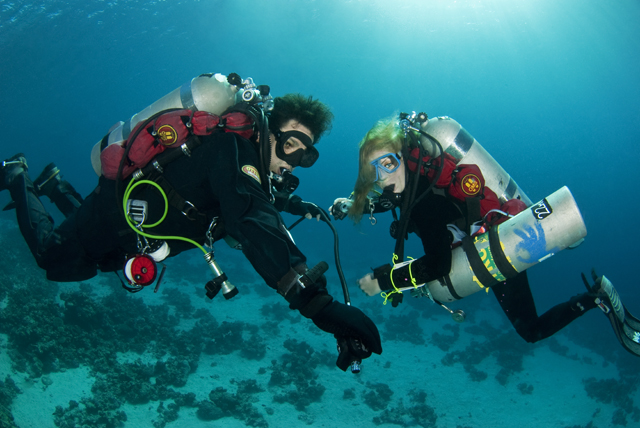News
Girls do Tech
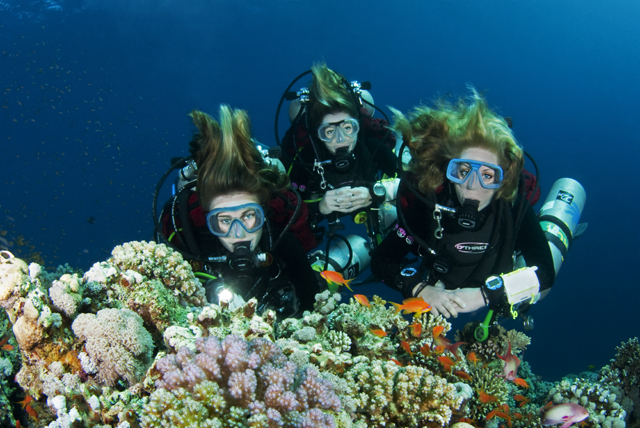
What happens when you put three women on a PADI tec 40 and tec 45 course? Well, the short answer is – plenty! The wheel of destiny had already started turning way before I arrived in Dahab. Here is the complete story, warts-n-all….
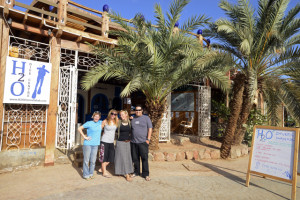 Sam Helmy, the owner of H2O divers, had mentioned that technical diving was male dominated. His estimates were in the region of 90% male to 10% female, so out popped a novel idea to write a story called ‘girls do tech’ thus homing in on the feminine aspect and promote more interest from the fairer species.
Sam Helmy, the owner of H2O divers, had mentioned that technical diving was male dominated. His estimates were in the region of 90% male to 10% female, so out popped a novel idea to write a story called ‘girls do tech’ thus homing in on the feminine aspect and promote more interest from the fairer species.
My plan was to follow the trials and tribulations of three women working their way through the PADI tec 40 and tec 45 courses, relay their thoughts, hardships, aspirations etc.
Sam’s original tech girl line up included Danielle, Trudy and Laura. Danielle was an active PADI Instructor with some experience using twinsets, Trudy was on the way to becoming a PADI Divemaster with plenty of recreational experience and Laura, being Sam’s girlfriend, had already gained a reasonable amount of tech diving experience while working in Dahab.
The tec 40 course is basically the first rung on PADI’s technical diving ladder. It consists of 4 dives, the final dive no deeper than 40m, with some no accelerated decompression using a single stage cylinder filled with a deco gas mix of up to 50% oxygen. Sam’s personal preference is to get divers using twinsets as quickly as possible, which might be slightly uncomfortable for some, but in the long term it’s probably the best option. Any PADI dive centre will have the full list of prerequisites for the course (or just look online).
We were on quite a tight timescale as both of the tech courses required a reasonable amount of theory as well as practical work. Unfortunately Trudy’s luggage had been ‘mislaid’ somewhere at the airport so she would have to make do with the clothes on her back and any hand-me-downs from the girls working at the centre until it could be found. This turned out to be an ongoing saga with daily phone calls to and from the airport at Sharm El Sheikh. Trudy’s bag finally materialised 10 days later on the morning she was leaving! Stress levels were slightly elevated but this wasn’t an out an out show stopper.
So all three girls happily (apart from Trudy) got through the first day of training, completing all the theory as well as spending a few hours setting up twinsets, adjusting harnesses and generally getting used to all the new unfamiliar equipment. H2O’s course prices include the use of all tech equipment, gas, transportation and shore dives.
The fun and games began on the second day. Trudy was suffering from stomach cramps (possible food poisoning) so managed to complete the theory but opted out of the diving. H2O is situated on the sea front so for the initial training dives it was just a case of kitting up and walking straight into the sea directly in front of the dive centre. The underwater visibility was below average and there were one or two overly inquisitive lionfish to contend with but otherwise Danielle and Laura completed the skills without any major problems. This included valve shut downs, out of gas scenarios, removing and replacing stage cylinders and DSMB deployment. Trudy would have to play catch up but we could hopefully still get both courses finished in the required time frame.
On day three, Trudy’s so called food poisoning cramps were re-assessed by the doctor as acute appendicitis and she had to be operated on immediately. By this time everybody had been running back and forth to the hospital (my thanks to DAN for their rapid response and extremely professional manner when dealing with the situation) and stress levels were pretty high, which is not the best atmosphere for a tech diving course – or in fact any course – but then shit happens.

 So looking at the half time scoreboard I had two stressed out girls still in play with number three girl totally crocked. Sam called in a few favours and the very next morning Jenny appeared as a substitute. Jenny was a freelance diving and climbing Instructor working in Dahab. She had plenty of recreational experience and some basic tech knowledge so was able to pick up the reins quite quickly.
So looking at the half time scoreboard I had two stressed out girls still in play with number three girl totally crocked. Sam called in a few favours and the very next morning Jenny appeared as a substitute. Jenny was a freelance diving and climbing Instructor working in Dahab. She had plenty of recreational experience and some basic tech knowledge so was able to pick up the reins quite quickly.
The PADI tec 45 course follows on from the tec 40 course and introduces divers to limited accelerated decompression dives using a single stage cylinder with a deco mix of air or EANX up to 100% oxygen. There are 4 dives and the last dive is no deeper than 45m. Each dive also includes a series of experience building skills and drills so the girls weren’t getting away lightly.
The last few days seem to settle down quite nicely and we managed to get a good routine going. On the last tec 45 dive I wanted to get a group shot of Sam and the girls inside Dahab’s infamous blue hole. I was also trying to get pictures for a deep Dahab article so I made arrangements to meet the girls en mass during their descent. I started my dive at Bells, passed through the Archway at 60m and met them on my way back up. This required spot on timings. Thanks to Sam and Jaimie the dive went according to plan. I met the girls at 45 metres and got my picture. After a full 10 days worth of fun and games this was a fitting end to the ‘girls do tech’ saga. As far as I know Trudy has fully recovered from her unfortunate ordeal.
For reference a fully rigged twinset (twin 12’s) weighs around 45kg. With additional trim weights this could be as much as 60kg. Add a stage cylinder weighing in at approx 10kg and the total weight might be as much as 70kg. The ‘average’ girl weighed in at around 55kg so considering we were doing shore dives and they had to carry all their own kit this was quite an impressive feat.
I sat down and went through the PADI tec 40 and tec 45 courses with each girl in person. I asked a number of set questions just to get an overall perspective.
Girl 1
Name: Laura Dinraths, 28
Cert: PADI OWSI
Began diving: 1998
Number of dives: 1400+
Nationality: Belgian
Employed: H2O Divers, Dahab, Egypt
Height: 1.6m
Weight: 51kg
Q1. Why do tech?
A1. Stick with the boys! Like the change and the challenge. Also like learning new things.
Q2. Why do the PADI tech course?
A2. The PADI courses open new possibilities from CCR to using sidemounts.
Q3. What about the course itself?
A3. Challenging and fun. It’s an interesting step for women to take. I would get some experience first. You need to be a good diver and you need to be confident. Tech diving is not for everybody. The equipment is different but you get used to it. It’s no more difficult for a man.
Q4. How did you find the twinset?
A4. Heavy! It’s difficult to keep my balance when I walk. Not the same as using singles, you have to get used to it.
Q5. What about Shut downs?
A5. Not difficult but at first I got confused with screwing and unscrewing! But I can reach the knobs okay.
Q6. What about attaching/detaching stages to the D-rings?
A6. This is when I swear a lot. They are more difficult to do but again you get used to it.
Q7. Deploying D-SMB’s?
A7. As long as I take it calmly and think what I’m doing it all works out okay.
Q8. How did you find Sam as an Instructor?
A8. He’s very experienced and knows students’ strengths and weaknesses.
Q9. And finally now the course is over?
A9. Tired, excited and happy! I’m looking forward to moving on to the next level.
Girl 2
Name: Jenny Lord, 30
Cert: PADI OWSI
Began diving: Aug 2008
Number of dives: 850+
Nationality: British
Employed: Freelance diving and climbing Instructor
Height: 1.73m
Weight: 55kg
Q1. Why do tech?
A1. Keep me on my toes. Push my skills, learn new things. It’s nothing to do with depth it’s more to do with time and skills.
Q2. Why do the PADI tech course?
A2. I’m a PADI Instructor so it’s the logical step.
Q3. What about the course itself?
A3. I already knew what to expect from friends. I wanted to push myself but not more than I can cope with. It’s a challenge. We are better on gas than men so someone has to carry the extra bail out gas!
Q4. How did you find the twinset?
A4. I had a lot of comments. They are almost the same size as me! But I got used to it. Underwater it makes no difference – you just need good shoes for the beach entries.
Q5. What about Shut downs?
A5. At first it was awkward reaching around but I have good flexibility due to my climbing. It’s just a matter of learning where to touch.
Q6. Deploying D-SMB’s?
A6. At first I had a problem deploying them but I got used to it.
Q7. How did you find Sam as an Instructor?
A7. He’s an excellent Instructor and has a good manner. The course was pitched at my level. If I was struggling he gave me time to practice.
Q8. And finally now the course is over?
A8. There are not so many women in tech diving but there is no reason why not. We are just as capable as men and in some respects we are more cautious, safer, better. There are ways around the weight of the kit. It shouldn’t be a restriction.
Girl 3
Name: Danielle Moss, 24
Cert: PADI OWSI
Began diving: 2007
Number of dives: 1000+
Nationality: British
Employed: Starfish Diving School, Malta
Height: 1.65m
Weight: 65kg
Q1. Why do tech?
A1. Shipwrecks interest me. The deeper wrecks are better. Going tech gives me more bottom time.
Q2. Where do you see your level?
A2. I want to do the tec 50 asap. I will go all the way to tec trimix 65.
Q3. Why do the PADI tech course?
A3. All my courses have been PADI up until now. They are well respected and have high standards.
Q4. What about the course itself?
A4. It went brilliantly. Sam’s abilities to re-organise are exceptionally considering the circumstances. I had to be super disciplined for levels and timings. To execute the plan correctly I had to really concentrate. I don’t think a lot of recreational divers will be interested in tech. You need to have a high skill level and be able to adapt to change. It’s a big step up, not for bumblers.
Q5. How did you find the twinset?
A5. At first it was cumbersome but now I don’t think about it. Walking down to the beach it is heavy but not unbearable. The staff carried the stages which helped.
Q6. What about Shut downs?
A6. No problems, easy to reach.
Q7. What about attaching/detaching stages to the D-rings?
A7. No problems at all… but not sure how easy it will be when I get back in my drysuit.
Q8. Deploying D-SMB’s?
A8. No problems, seemed natural.
Q9. How did you find Sam as an Instructor?
A9. Phenomenal, very thorough. He went way beyond what was necessary. He even added extra theory.
Q10. And finally now the course is over?
A10. I feel confident. I have mastered the skills but need to be more competent. I need to keep sharpening my skills. As soon as I get back to Malta I will be asking the dive centre for a twinset.
From the Instructor
Sam Helmy is a qualified PADI Trimix Instructor. He has been diving for 25 years and been involved in tech for 8 years. He has lived in Dahab for 9 years and has spent the past 18 months running H2O dive centre. Total number of dives to date is around the 5,000 mark.
Sam’s summary: “They all did really well. They were very switched on. We had no major problems, it just took a little bit of repetition to get used to the skills. Men have the same problems. I think there are not so many women in tech diving because it has a macho image and is equipment intensive. Tech diving is suited for some and not for others; it’s the same scenario for men. Physically it can be an issue lugging equipment but women usually have lower SAC rates than men so smaller tanks help. There is no problem with the theory.”
Sam told me the PADI tech courses are nicely broken down into bite size pieces. In the future he wants to get involved in more exploration, teaching CCR, cave and instructor levels.
Gear News
Introducing the TR-80, IR-50 and CS-30 Regulators from DYNAMICNORD

Whether you are a beginner or a professional diver – with the three new main regulators from DYNAMICNORD, everyone will find their favourite regulator. They all look super stylish.
Excellent performance with the TR-80
Quality and performance are the be-all and end-all for regulators. It is not for nothing that the TR stands for Tec Reg. The innovative design of the TR-80 guarantees absolute reliability – even in ice-cold waters.

Perfect breathing effort at 0.8 J/l / certified for diving in waters below 10 degrees / structural design made of solid brass for best cold protection / membrane-compensated design with dry seal of the first stage / reduced exhalation effort thanks to optimized exhalation membrane and bubble deflector / adjustable Venturi (dive/predive) and adjustment knob for individual inhalation comfort / innovative design of the front cover prevents free-flow in strong currents or when diving with scooters / design made of sandblasted brass, matt chrome finish / 2 HP and 4 LP outlets / mouthpiece made of high-quality, anti-allergic silicone for maximum comfort.


Amazing underwater adventures with the IR-50
The IR-50 is the top regulator for advanced and experienced divers. Natural breathing is the essence of this regulator.

Ideal breathing effort at 0.8 J/l /certified for diving in waters below 10 degrees / compensated membrane / adjustable venturi (dive/predive) and adjustment knob for individual inhalation comfort/ outlet valve and deflector for minimum exhalation effort and reduction of bubbles on the face / design made of sandblasted brass, matt chrome finish / 2 HP and 4 NP outlets / mouthpiece made of high-quality, anti-allergic silicone for maximum comfort.


The Workhorse – our CS-30
For diving centres and diving beginners – the workhorse stands for strong construction, reliability and robustness. Perfect for your training.

Optimal breathing effort at 0.8 J/l /recommended for diving in waters above 10 degrees / non-compensated piston / adjustable venturi (dive/predive) / outlet valve and deflector for minimum exhalation effort and reduction of bubbles on the face / design made of sandblasted brass, matt chrome finish / 1 HP and 3 NP outlets / mouthpiece made of high-quality, anti-allergic silicone for maximum comfort.


Octopus OP-30
The OP-30 is the ideal addition to all DYNAMICNORD regulators. It is identical in construction to the CS-30.

The TR-80, IR-50, CS-30 (DIN & INT) regulators and the Octopus OP-30 are available from DYNAMICNORD dealers and in the online store.
DYNAMICNORD – Your Outdoor Companion.
Marine Life & Conservation
Paul Watson Released as Denmark Blocks Japan’s Extradition Bid

Renowned anti-whaling activist Paul Watson has been released from custody in Greenland after spending five months in detention. Denmark’s Justice Ministry rejected Japan’s request for his extradition, citing insufficient guarantees that his time already served in custody would be credited against any potential sentence.
The 74-year-old Canadian-American was arrested on July 21 in Nuuk, Greenland’s capital, when his ship docked to refuel. His arrest was based on a 2012 Japanese warrant related to a 2010 encounter in Antarctic waters. Japan alleged Watson obstructed operations and caused damage to a whaling research ship during efforts to disrupt illegal whaling. Watson has consistently denied these claims, maintaining his commitment to marine conservation.
Denmark, which oversees extradition matters for Greenland, concluded that while the legal conditions for extradition were met, the lack of assurances from Japan regarding time-served credit made extradition untenable.
In a video shared by his foundation, Watson expressed gratitude and relief, saying, “After five months, it’s good to be out… and good to know they’re not sending me to Japan.” He added that the most difficult part of his time in custody was being separated from his two young sons.
Watson is a pioneering figure in marine conservation, known for founding the Captain Paul Watson Foundation in 2022 after decades of activism with the Sea Shepherd Conservation Society. His bold efforts to defend marine life have earned him widespread support, including from celebrities and conservationists. His work has also been featured in the acclaimed reality TV series Whale Wars.
Watson’s lawyer, Jonas Christoffersen, praised the decision, stating, “We are happy and relieved that Paul Watson is now free.” He added that Watson is eager to reunite with his family and continue his vital work.
The arrest occurred while Watson’s vessel, the M/Y John Paul DeJoria, was en route to the North Pacific with a team of 26 volunteers to intercept a Japanese whaling ship. His foundation described the arrest as politically motivated and emphasized that Watson’s actions were focused on ending illegal whaling practices.
Japan resumed commercial whaling in 2019 after leaving the International Whaling Commission, asserting that whale meat is a cultural tradition. Conservationists, however, continue to challenge these practices, highlighting their impact on marine ecosystems.
Despite the challenges, Watson remains steadfast in his mission to protect marine life and bring attention to whaling practices. His dedication to ocean conservation has made him a globally respected advocate for the environment.
-

 News2 months ago
News2 months agoIconic SS United States to become the World’s Largest Artificial Reef
-

 News3 months ago
News3 months agoBook Review – 52 Assignments: Underwater Photography
-

 Gear News3 months ago
Gear News3 months agoDYNAMICNORD – New German diving brand enters the British market
-

 News3 months ago
News3 months agoExploring Cenote El Pit: A Diver’s Dream
-

 Gear News3 months ago
Gear News3 months agoTry BARE drysuits (and maybe even win one!) this Friday with Sea & Sea at North West Dive Fest
-

 Marine Life & Conservation3 months ago
Marine Life & Conservation3 months agoBook Review: Coral Triangle Cameos
-

 Blogs2 months ago
Blogs2 months agoDive the Egyptian Red Sea this Autumn with Regaldive
-

 News3 months ago
News3 months ago2024 Ocean Art Underwater Photo Competition Announced


